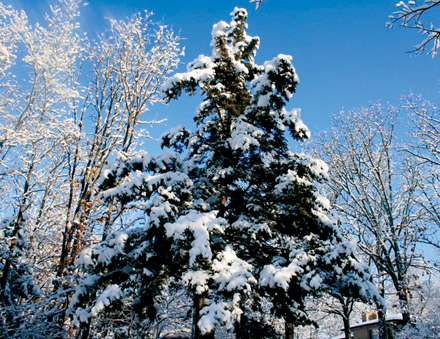Real or Fake Christmas Tree?

When I married someone who wanted to go out into the woods to cut down a tree to decorate, I frankly balked. As a gardener who regularly planted trees, the thought of cutting one down for a mere few weeks didn’t make sense so we compromised. One tree could be cut down as long as we planted one to even the score.
Since then, there’s been an interesting shift in terms of what is considered to be environmentally friendly. Today using cut trees is considered eco-friendly because they are a renewable and biodegradable natural resource. On average, it takes about seven years to raise a Christmas tree to marketable size. During that time, it is absorbing carbon dioxide and filtering the air and releasing oxygen. It is providing watershed protection and habitat for birds and other wildlife. Christmas trees are planted and raised as a crop by tree farmers. Unlike other row crops, a Christmas tree plantation remains green and growing year-round. If there was no market for real Christmas trees, that land would probably be developed for something else so there’s something to be said for keeping another piece of land in a green strip.
In contrast, artificial Christmas trees are made primarily of metals and plastics, which are all non-renewable resources. The plastic material, typically polyvinyl chloride (PVC), is a potential lead source. The potential for lead poisoning is considered high enough that California requires a warning label on all artificial trees made in China, and an estimated 85 percent of artificial trees are made in China. Additionally, these trees must be transported 8,000-plus miles to their U.S. destination, which emits additional CO2.
On average, an artificial tree is used for seven years before it ends up in the landfill. Regardless of how many years it is used, it is still going to end up in a landfill far longer. In contrast, a real tree can be composted, submerged in ponds for fish habitat or made into wood chips. I still contend a tree should be planted for every one cut down, even ones cut from tree farms.
Now there are a couple more good uses for artificial trees. My 18-year old cat, Margaret, used to like to climb the Christmas tree so she would get one all her own, without lights or ornaments, tied to a post. Somehow she knew it was hers and would spend hours underneath it napping or waiting for someone to walk by she could ambush. Now that she’s older she still likes to nap under the tree so artificial trees make nice cat toys. She’s no longer interested in climbing so the extra tree top is becoming a door wreath. Artificial trees can be made into swags and garlands, and you can hang one upside down and join the latest Christmas décor trend. Or let your cat do it for you.
From our tree to yours, Merry Christmas!
Charlotte Ekker Wiggins is a beekeeper, gardener and sometimes cook. Published by El Dorado Springs Sun once in print and online with author’s permission. Copyright 2017, all rights reserved. This column may not be reprinted, republished or otherwise distributed without author’s permission. Contact Charlotte at gardeningcharlotte at gmail dot com.

YEAR ROUND CHEER – This little artificial Christmas tree spends most of the year in my business office, then moves down to spend December in my kitchen so it gets good use every day of the year.
 THE REAL DEAL – My favorite kind of Christmas tree, alive, outside and covered with snow. Merry Christmas! (Photos by Charlotte Ekker Wiggins).
THE REAL DEAL – My favorite kind of Christmas tree, alive, outside and covered with snow. Merry Christmas! (Photos by Charlotte Ekker Wiggins).



Facebook Comments